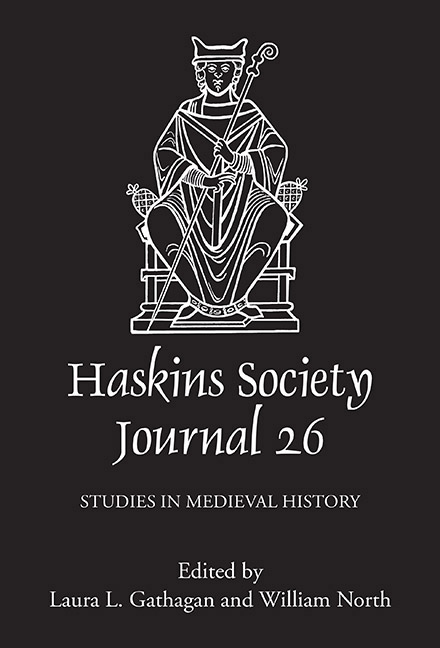Book contents
- Frontmatter
- Contents
- List of Figures
- Editors’ Note
- Abbreviations
- 1 Mores Tuos Fabricae Loquuntur Building Activity and the Rhetoric of Power in Ostrogothic Italy
- 2 A Hermeneutical Feast: Interreligious Dining in Early Medieval Conciliar Legislation
- 3 A Hypothetical Slave in Constantinople: Amalarius’s Liber Officialis and the Mediterranean Slave Trade
- 4 Welsh Kings at Anglo-Saxon Royal Assemblies (928–55)
- 5 The Diplomatics of Depredation: Reconsidering Holy Trinity Caen’s List of Losses
- 6 When Did Robert of Torigni First Receive Henry of Huntingdon’s Historia Anglorum, and Why Does It Matter?
- 7 A Coin Bearing Testimony to Duchess Matilda as Consors Regni
- 8 Fighting to be the Tallest Dwarf: Invidia and Competition in the Self-Conception of Eleventh- and Twelfth-Century Masters
- 9 Brut y Tywysogion: the History of the Princes and Twelfth-Century Cambro-Latin Historical Writing
- 10 The Use of English Annalistic Sources in Medieval Welsh Chronicles
- 11 A Franco-Danish Marriage and the Plot against England
10 - The Use of English Annalistic Sources in Medieval Welsh Chronicles
Published online by Cambridge University Press: 25 May 2021
- Frontmatter
- Contents
- List of Figures
- Editors’ Note
- Abbreviations
- 1 Mores Tuos Fabricae Loquuntur Building Activity and the Rhetoric of Power in Ostrogothic Italy
- 2 A Hermeneutical Feast: Interreligious Dining in Early Medieval Conciliar Legislation
- 3 A Hypothetical Slave in Constantinople: Amalarius’s Liber Officialis and the Mediterranean Slave Trade
- 4 Welsh Kings at Anglo-Saxon Royal Assemblies (928–55)
- 5 The Diplomatics of Depredation: Reconsidering Holy Trinity Caen’s List of Losses
- 6 When Did Robert of Torigni First Receive Henry of Huntingdon’s Historia Anglorum, and Why Does It Matter?
- 7 A Coin Bearing Testimony to Duchess Matilda as Consors Regni
- 8 Fighting to be the Tallest Dwarf: Invidia and Competition in the Self-Conception of Eleventh- and Twelfth-Century Masters
- 9 Brut y Tywysogion: the History of the Princes and Twelfth-Century Cambro-Latin Historical Writing
- 10 The Use of English Annalistic Sources in Medieval Welsh Chronicles
- 11 A Franco-Danish Marriage and the Plot against England
Summary
The remarkable flowering of vernacular writing which occurred in thirteenthand fourteenth-century Wales saw the composition of numerous original works of both prose and poetry, the compilation of several annalistic chronicles, and a proliferation of translations from Latin into Welsh of texts ranging from religious, to historical, to literary. At this time, monastic scriptoria and laypeople alike produced the great manuscript compendiums of medieval Wales, including the Red Book of Hergest, the White Book of Rhydderch, and the Hendregadredd manuscript. A great deal of this manuscript activity occurred in Cistercian houses. Impetus for this flurry of textual production is often attributed to the termination of Welsh independence in 1282, and the events leading up to it, since the thirteenth century witnessed, first, the possibility of Welsh independence through the ascendancy of Llywelyn ap Gruffudd, last prince of Wales, over the Welsh principality, and, then, the demise of these ambitions upon his beheading in 1282 and Edward I's subsequent conquest of Gwynedd. A vast political and cultural restructuring then followed, and it is these changes that can be seen as motivating the literary activity of the period. Though it must also be kept in mind that some of this material was compiled, translated, or redacted prior to the conquest of Gwynedd, during its ascendancy c. 1255–1267, the production of these texts was undoubtedly inflected by issues of sovereignty, independence, and the threat of loss, and it is in this light that I view the historical chronicles produced throughout the period.
In particular, Geoffrey of Monmouth's De gestis Britonum, wholly translated from Latin into Welsh c. 1200–1250 as Brut y Brenhinedd ‘History of the Kings’, loomed large in the historiographical scene from shortly after it appeared in the 1130s. By definition dealing with themes of British unity, loss of sovereignty, and political fragmentation, Brut y Brenhinedd is found in several Welsh manuscripts of this period sandwiched between a Welsh translation of Dares Phrygius’ De excidio Troiae and a Welsh vernacular chronicle Brut y Tywysogyon ‘History of the Princes’, which picks up the history of Wales where Geoffrey left off, a task which he left to Caradog of Llancarfan in his colophon. In other manuscripts, the Welsh translation of De excidio Troiae and Brut y Brenhinedd are followed by Brenhinedd y Saeson ‘Kings of the English’, a Welsh vernacular chronicle detailing the history of the kings of Anglo-Saxon England.
- Type
- Chapter
- Information
- The Haskins Society Journal 262014. Studies in Medieval History, pp. 229 - 248Publisher: Boydell & BrewerPrint publication year: 2015

